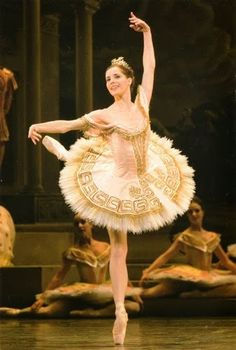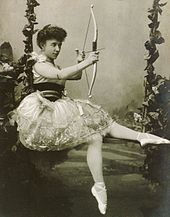#Throwback Thursday: Sylvia
- Selene
- May 11, 2017
- 5 min read
This week's #ThrowbackThursday is on the ballet Sylvia.

Gillian Murphy and Maxime Beloserkovsky, American Ballet Theatre, 2005
Sylvia, ou La nymphe de Diane (Sylvia, or the Nymph of Diana) is a two or three act narrative ballet. First choreographed by Louis Merante in 1876, the libretto is based off Torquato Tasso's 1573 play Aminta. Despite this, the plot is rather unusual and some have called it the ballet's weak point.

The Royal Ballet
Act I begins in a forest with a scene of ritual dancing in honour of Eros, the god of love. Aminta, a shepherd, accidentally interrupts the festivities. His accidental gate-crashing interrupts the intentional gate-crashing of Sylvia. Sylvia takes her cues from the goddess Diana, and she and her band of maiden huntresses have come to mock the rites to Eros. Believing Aminta, who is in love with her, to be stalking her at the command of the god, Sylvia aims her bow at Eros, who is protected by Aminta. Aminta is wounded by her arrow, and Eros in turn shoots Sylvia with his enchanted bow. Though the arrow barely scraped her and she flees the scene.

Zenaida Yanowsky and David Makhateli, The Royal Ballet
Another hunter, Orion, arrives on the scene. He too is in love with Sylvia and exalts when he sees his rival, Aminta, unconscious on the ground. He conceals himself as Sylvia returns. She is sympathetic towards Aminta, arousing Orion's jealousy. As she laments over Aminta, Orion kidnaps her. Eros returns in disguise and revives the shepherd, then reveals himself and tells Aminta of Orion's crime.

Celine Gittens, Birmingham Royal Ballet
In Act II, Sylvia is trapped on Orion's island. He tempts her with jewels and wine without success; Sylvia is now grieving for Aminta, cherishing the arrow which scraped her skin. Jealous, Orion steals the arrow from her, and in revenge Sylvia gets her captor blind drunk. When he falls unconscious, she steals back the arrow and prays to Eros for aid. Her appeals summon the god himself, who shows her a vision of Aminta waiting for her at the Temple of Diana.

The Royal Ballet
Act III begins with Aminta waiting at the Temple for Sylvia's arrival. She and Eros quickly arrive, but the reunion is short, for Orion appears searching for her. Sylvia barricades herself in the sanctum of the temple, and when Orion attempts to follow her, he and Aminta fight. Outraged by Orion's disregard of her temple's sanctity, Diana smites him and forbids Aminta and Sylvia to marry. Eros grants Diana a vision of the love she once had for Endymion, and Diana relents. With the blessings of the gods, Sylvia and Aminta marry.

Darcey Bussell, The Royal Ballet
In 1875, the Paris Opera chose Jules Barbier and the Baron de Reinach to write the libretto for Sylvia. Merante was chosen to choreograph both because of his extensive experience and because no other choreographer was available at the time. The score was to be composed by Leo Delibes, but this turned out to be a gruelling process, with many revisions and restarts due to Merante's demands regarding choreography. When rehearsals began on August 15, 1875, only a third of the score was finished.

Leo Delibes
Sylvia was to be the first ballet to premiere on the stage of the brand new Opera Garnier, and did so in opulent style. It premiered on June 14, 1876, but was largely unnoticed. Jules Cheret's extravagant sets were poorly lit, detracting from their effect, though Lacoste's costumes were well-received. The star of the ballet was Rita Sangalli, the 27-year-old prima ballerina of the Paris Opera. Reports indicate that despite a 'superb physique', Sangalli was not an overly accomplished dancer; nevertheless, she had no understudy and no other ballerina was taught the role. Thus, when Sangalli injured herself, the entire production had to be put on hold. In fact, the ballet might have been lost entirely if not for Delibes' exquisite score, which gained widespread praise.

Opera Garnier, lithograph
Excerpts of the ballet were staged in Russia for Antonietta Dell'Era (creator of the Sugar Plum Fairy in The Nutcracker) in 1886, and the full-length work was staged for Carlotta Brianza (creator of Aurora in The Sleeping Beauty) in 1892, but these were not successes. A revival was planned for the Mariinsky's 1900-1901 season, to be staged by Sergei Diaghilev with costumes by Alexandre Benois and choreography by Nikolai and Sergei Legat. However Diaghilev argued with the Director of the Imperial Theatres, Prince Volkonsky, leading to his resignation and the eventual formation of the Ballets Russes in 1909. The ballet was rescheduled for the 1901-1902 season, under the direction of Lev Ivanov. However, Ivanov merely changed the title of the ballet to simply Sylvia before an ill-timed death, at which the project was passed onto Pavel Gerdt, noted danseur of the Imperial Theatres.

Olga Preobrajenska as Sylvia, 1901
The cast of this production included Olga Preobrajenska as Sylvia and Sergei Legat as Aminta. Pavel Gerdt created the role of Orion, and among the nymphs of the goddess Diana was to be found a young Agrippina Vaganova. The production premiered on December 15, 1901. Despite the stunning success of Preobrajenska, the production as a whole was a flop. The critics, including noted ballet expert Sergei Khudekov (who had himself authored several librettos for the Mariinsky), blamed poor choreography and a weak script. This was not helped by the fact that no new set pieces were commissioned, and so the set was cobbled together from existing pieces created for now obsolete ballets. After only five performances the ballet was taken from the repertoire, though excerpts continued to be performed at galas.

Nadia Nerina and Gary Sherwood, 1967
Such excerpts were occasionally performed by Anna Pavlova and her company while on tour to London. It is here that a young Frederick Ashton first saw the ballet, which he would later recreate for Margot Fonteyn in 1952. According to legend, Ashton began his re-staging when, in 1946, he had a dream that Delibes appeared to him and charged him with saving his ballet. Ashton designed the entire ballet as a tribute to Fonteyn, who found great success with this strong lead role. The ballet premiered at the Royal Opera House in London on September 3, 1952. The cast included Margot Fonteyn as Sylvia, Michael Somes as Aminta, John Hart as Orion, and Alexander Grant as Eros.

Margot Fonteyn as Sylvia, 1952
Other modern productions include the piece created for the San Francisco Ballet in 2004 by Mark Morris, the only modern production not to be based off of Ashton's revival, but off the original ballet. Morris justified this by saying that Delibes' score is indelibly entwined with Merante's original choreography, revised as it was to fit what Merante wanted. This production, unlike its inspiration, is a success. The Royal Ballet continue to perform Ashton's Sylvia, which inspired the American Ballet Theatre production. This version of Sylvia has been cut into two acts (music from the ballet La Source, utilised in the original, has been cut). This version is also a success.
Here's Darcey Bussell performing Sylvia's Act I variation in Ashton's version:
And the so-called Sylvia pas de deux, choreographed by George Balanchine for ABT, with Martine van Hamel and Patrick Bissel:
Thanks for reading!
- Selene
































Comments